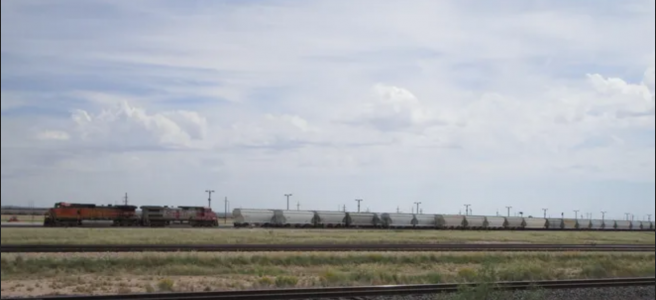
Adrian Hedden | Carlsbad Current Argus | 10/22/2020
Economic analysts warned that New Mexico could be unable to rely on its oil and gas industry as the market continues to struggle amid the COVID-19 pandemic.
Lease fees, royalty payment and taxes from oil and gas operations accounted for about 30 percent of the state’s budget in recent years, per a recent study from the Institute for Energy Economics (IEEFA) and Financial Analysis.
The industry also provided about a quarter of the state’s operations budget last year, the study read.
But with the price per barrel of oil declining — before the pandemic a 22014 boom busted about a year later — the financial support the industry offers New Mexico could be weakening, the study read.
Earlier this year, lawmakers faced a $400 million shortfall in the state’s budget which many attributed to declines in the oil and gas markets.
As of Tuesday, domestic crude oil was trading at about $41 per barrel, per data from Nasdaq, after a historic plummet in April when the pandemic took hold in the U.S. to less than $0 per barrel for the first time in history.
Before the pandemic, oil was priced at about $55 to $60 per barrel, with the study reporting an average of about $48 per barrel between 2015 and 2019.
Between 2010 and 2014, the study reported the average price of oil was about $86 per barrel.
That meant shrinking operations in New Mexico where oil and gas development is centered around the Permian Basin in the southeast, with Baker Hughes reporting an average of 45 active rigs so far in October, marking a drop of 67 rigs or a 60 percent decrease since October 2019.
Most of those rigs were lost in recent months as the health crisis grew, after the year started off strong at an average of 106 rigs in January and steadily declined through the spring and summer.
Co-author of the IEEFA report Tom Sanzillo said estimates show the average price of oil will remain as low as $43 per barrel through 2022.
“It’s an improvement over the historic lows hit in April 2020, but still far below what’s needed to return New Mexico to robust fiscal health,” he said. “The situation is unlikely to improve anytime soon.”
While prices saw some recovery since plummeting in April, they would need to stay at an average of $80 per barrels for several years, the study read.
Oil and gas reserves would need to rise quickly, while companies must be able to pay off debt.
At the same time, fuel demand would have to increase significantly, the study read, even after the pandemic and subsequent travel restrictions saw it plummet.
“These features need to be in alignment, a scenario that is highly unlikely,” read the study.
Also blocking the industry’s path to recovery were high infrastructure costs, oversupply and increasing competition from the renewable sector, read the study.
“Consequently, the industry’s future is likely to be one of long-term decline,” the study read.
Sanzillo said New Mexico should no longer seek to rely on its fossil fuel industry and should diversify its economy to survive the inevitable busts of oil and gas.
“New Mexico can no longer expect oil and gas revenues to bounce back. But the negative outlook for the oil and gas industry does not have to be a negative outlook for New Mexico,” he said.
“If heeded, this warning can result in New Mexico capturing what remains of oil and gas revenues and building future economic growth on a broader, more secure foundation.”
New Mexico’s lawmakers appeared to be taking heed of such warnings as the Legislature hopes to balance the state budget in the upcoming January 2021 Legislative Session.
A Sept. 30 presentation from the Legislative Finance Committee warned that the reduction in drilling activity led to less revenue through gross receipts tax (GRTs), also known as sales taxes, especially in Eddy and Lea counties in the southeast.
“Low oil prices and falling rig counts fueled a sharp decline in gross receipts in Eddy and Lea counties from April to July,” read the presentation. “Continuing declines in drilling related activity is driving most of the projected GRT declines in (Fiscal Year) 21.”
Production in FY 2021 was expected to continue its decline between 13 and 30 percent, the LFC reported.
New Mexico produced about 368 million barrels of oil in Fiscal Year 2020, records show, and the LFC predicted production would drop to 260 million to 320 million barrels in FY 2021.
Production of natural gas was also expected to decline by 7 to 10 percent in FY 2021, per the presentation.
James Jimenez, executive director of child advocacy group New Mexico Voices for Children said the state’s reliance on the volatile oil and gas industry led to drops in funding for education and other social services needed by the state’s youth.
“For too long New Mexico has been whipsawed by volatile oil and natural gas markets that our policymakers have no power to control. Once again low oil and gas prices are causing shortfalls in dollars needed in the state budget for our schools, public safety, health care, and more,” Jimenez said in a statement.
“We need bold and innovative solutions from our policymakers to accelerate the diversification of our state’s economy, create a more equitable and transparent tax system, and strategically invest in proven programs that deliver better outcomes for our children.”
Adrian Hedden can be reached at 575-628-5516,
or @AdrianHedden on Twitter.

